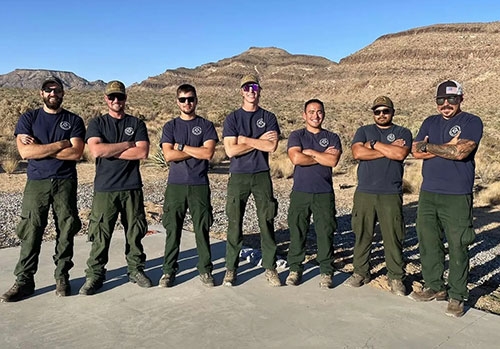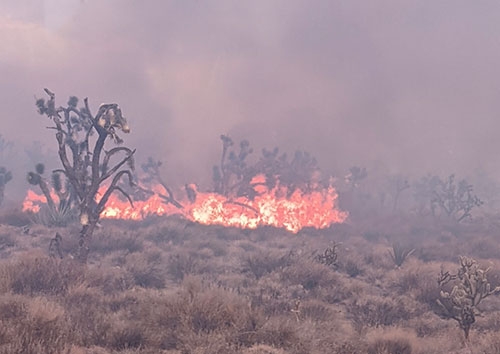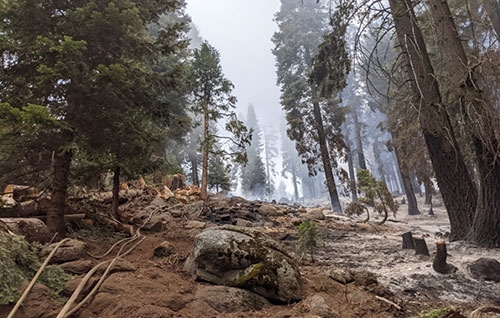You are here
Home ›Waukon High School graduate Cody Palmer shares his experience as a wildland firefighter out west in the Mojave National Preserve

His firefighting crew ... Pictured above is the 2021 Mojave National Preserve Park Service engine crew that 2021 Waukon High School graduate Cody Palmer (pictured in the center of the photo) was a part of this past summer and fall. Cody is the son of Bob and Sharon Palmer of the rural Waterville area. Submitted photo.

A blaze to battle ... View of a fire from the fire engine in Mojave National Preserve near the California/Arizona/Nevada border, where Waukon High School graduate Cody Palmer spent this past summer and fall as part of a wildlands firefighting crew. Palmer said this fire was started by lightning. Submitted photo.

A fireline ... Pictured above is a section of fireline in Sequoia and Kings Canyon National Park in the KNP Complex fire that Waukon High School graduate Cody Palmer helped battle this past year. A fireline is described as a break in the fire’s “fuel,” such as trees, brush and other vegetation, to prevent a fire from spreading. A fireline can be made by cutting, scraping or digging by machine or by hand. Submitted photo.
by Brianne Eilers
When asking most high school students what they would like to do after graduating high school, one might expect them to answer with something like attending college, military service or maybe working until they decide what they would like to do.
It isn’t often that a high school student might answer that question by saying that they are interested in becoming a wildland firefighter, but that is exactly how 2021 Waukon High School graduate Cody Palmer spent this past summer and fall after graduation. Cody graduated from Waukon High School May 24 of last year, had a graduation celebration at home May 27 and left to head west May 29 to pursue a firefighting interest that he might just have inherited.
Cody is the son of Bob and Sharon Palmer of the rural Waterville area, and he noted that his interest in fighting wildland fires came at a young age after finding pictures of his dad. Bob works for the National Parks Service, and he fought wildfires in Yellowstone National Park in 1988.
“I was probably around seven or eight when I found those pictures of my dad (fighting wildfires in Yellowstone),” Cody said.
Cody had participated in controlled prairie burns around here while attending high school, and interest in that area continued to develop as he moved closer to graduating high school. During his high school career, Cody began to develop plans for after graduation. His senior year, he expressed more interest in this field.
“My dad said he’d guide me through the process,” Cody said. Cody applied online through a federal government jobsite, usajobs.gov. for the position of Forestry Technician. The position is affiliated with several different government agencies, including the Bureau of Land Management, National Park Service and Forest Service.
THE CALL TO DUTY
After applying, Cody received a call and did a job interview over the phone right then and there. He was already taking an Emergencey Medical Technician (EMT) class, in addition to his regular high school courses, as well as attending Kirkwood Community College weekly for a firefighting class.
In February of 2021, Cody received confirmation that he had gotten the position. Prior to committing to the position, Cody did go and visit the station he would be located at in southern California. Cody was to be stationed in Mojave National Preserve.
Mojave National Preserve is located in the high desert, near the California/Arizona/Nevada border. Cody noted that the location of their station is “incredibly remote.” He explained that the nearest grocery store was about an hour and 15 minutes away. Las Vegas, NV is about an hour and a half north of the station location.
“Once I got out there, it was a bit of a shock for me,” Cody said. While he’s no stranger to traveling and visiting different places and cultures, it was different for him making this life change as an adult, on his own.
GETTING USED TO IT
Of course, conditions in the desert are much different than what residents are used to here in northeast Iowa, or the Midwest in general. Cody said it did take time to adjust to the do’s and don’ts of living in the desert and to get acclimated to the heat and dryness.
“There are Joshua trees out there, and shrubs and brush, so there’s very little shade,” he explained. “The terrain is rocky. It’s hot and dry.”
He noted that temperatures could reach 120° F to 125° F. The typical fire season runs from April/May into October/November in the western U.S.
ON THE JOB
As part of his new job, days were spent training and doing daily PT (physical training). The typical gear for a Forestry Technician like Cody included a fire pack, which weighs around 45 pounds average; hard hat; fire-resistant clothing called nomex that consisted of a yellow shirt and green pants; fire boots, which were heavy-duty leather boots; and various tools, depending on the job or situation. The firefighters spend all day on their feet when they are working.
“It’s a standing game,” Cody said, adding that it was a challenge for him to get used to being on his feet for up to 16 hours a day. Most days they work 10-hour days, but when on a fire assignment, firefighters work 16-hour days every day for two weeks.
Cody explained that there are different jobs or positions within the wildland firefighting structure. He worked on a wildland fire engine crew, on a type-three engine. He noted that there are six different types of fire engines with six being the smallest and one being the largest. He explained that types one and two would be what people are familiar with in a municipal firefighting situation. Fire engine types three through six are what they use for wildland fighting.
He noted that on a wildland engine crew like he belonged to, there are five people in the engine, plus a chase truck. Other areas of wildland firefighting include Handcrews, Helitack, Hotshots (an experienced handcrew) and Smokejumpers. Cody noted that Hotshots are known for working the hottest, most difficult parts of the fires.
Most of the fires that Cody and his crew dealt with involved either car fires or fires started by lightning strikes. “With lightning strikes, you often don’t know about them right away,” Cody explained. “They usually happen in remote areas.”
With the interstate highway close by, fires could also start from sparks off the road, cigarettes being tossed out the window of a vehicle or the car itself. While at the station, they were always on call, but under quieter conditions the crew typically worked four 10-hour days a week. If conditions were favorable for fires, they would often have to put in overtime.
Cody was able to get in on one fire assignment outside his district, even though the COVID-19 pandemic stalled the engine rotation. For two weeks, Cody’s engine and crew worked in Sequoia and Kings Canyon National Parks, on a fire called the KNP Complex. Cody noted that the fire burned a total of around 80,000 acres.
“This assignment was in timber, and the terrain was incredibly steep,” Cody noted.
PART OF THE JOB
One thing that really stuck with Cody was how trees, big trees including sequoia trees, would suddenly just fall over in the forest. Even if they didn’t see the trees fall, Cody said you would hear the booms from them falling. Falling trees and branches create a dangerous hazard, and he said that firefighters do get injured from falling trees and debris.
When on a fire, Cody explained that the engine crew’s job is to lay hose and extend it away from the engine, a process referred to as “hoselays”. Crew members carry rolls, or, as they call them, “sticks” of fire hose on their backs. The sticks of hose weigh between 30-35 pounds. In addition to the hose, crew members are also carrying their standard pack and possibly tools. A stick of hose is 100 feet long and each stick carries nine gallons of water per 100 feet.
Hoselays can be on flat ground, on a hill or up a steep incline. Crew members may also have to help dig a fire line or control line, which involves creating a barrier between unburned fuel and the fire by removing any fuel and digging down to bare soil. Cody noted that Handcrews do a lot of the digging, but engine crews also help with that.
PREPARING FOR THE FUTURE
Cody’s position is a seasonal one, and he’s currently furloughed and back in northeast Iowa for the winter. He explained that he is taking some college classes through Northeast Iowa Community College.
“I’m using this time to advance my studies and keep my momentum up,” he noted.
While there is a career ladder with wildland firefighting, Cody says he hasn’t decided if that is something he wants to pursue long term. “Its rewarding, hard work,” he said. However, pay isn’t the best. That does make it hard for fire crews to retain and recruit help. The work is demanding and dangerous, but the pay isn’t always reflective of that. Cody noted that even though the work is physically demanding and time-consuming, it does give him great satisfaction at the end of the day to know that he and his teammates have accomplished something. “I really like being able to work with a group towards a common goal,” he said.
He’s found it very rewarding to know that he’s put in a hard day’s work and accomplished something. He also feels that this has helped give him perspective on what it means to be out in the world and be successful and responsible. Cody feels that working as a Forestry Technician has helped him grow and mature.
WORDS OF ADVICE
While he admits that wildland firefighting is not a field for everyone, there are certainly individuals out there that are interested in it. For anyone who is considering this as a career option, Cody has some advice. “EMT training is a big thing,” he said. It’s also important to take a basic firefighting class. Being able to outline and demonstrate capabilities is a huge advantage. Knowing basic qualifications of the job is important. “You want to be able to demonstrate skills in areas that make you desirable for a job like this,” he said.
Applying for these types of jobs at the right time is important. Cody noted that September, October or November are a good time to submit an application.
This coming summer, Cody is working at Rocky Mountain National Park in Colorado for his new job on a Fuels Crew, which is a hybrid of a traditional Handcrew. He departed to begin that service in early April and is excited for this summer, along with what the future holds for him.

